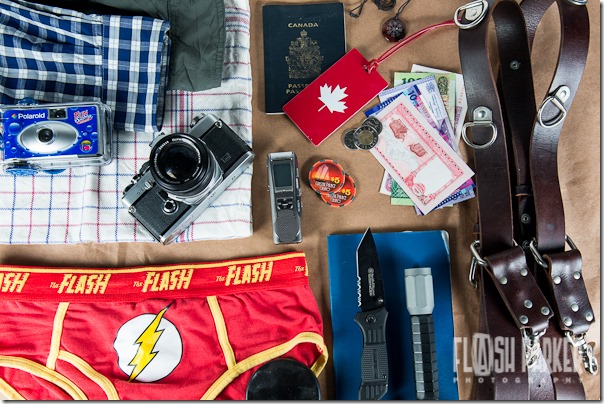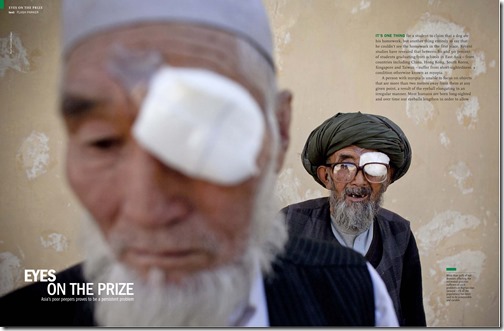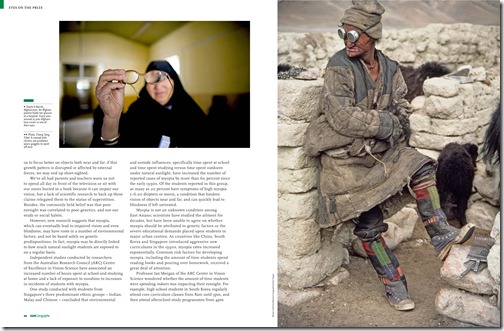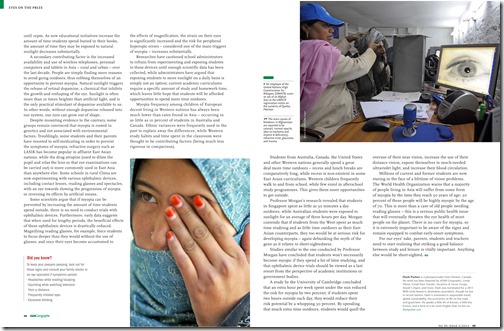
Trouble in Paradise
This article comes from Asian Geographic, Issue 2, 2013: Death & Decay. I’ve included the article as it appears in the magazine, as well as my original text. The photos provided for this article by Dr. Glenn Losack are stunning – I think this may be the most daring cover I’ve ever seen from a major publication. Pick up a copy of the magazine if you get a chance.
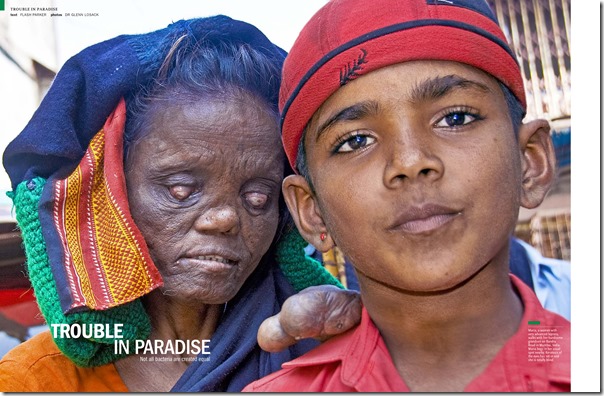
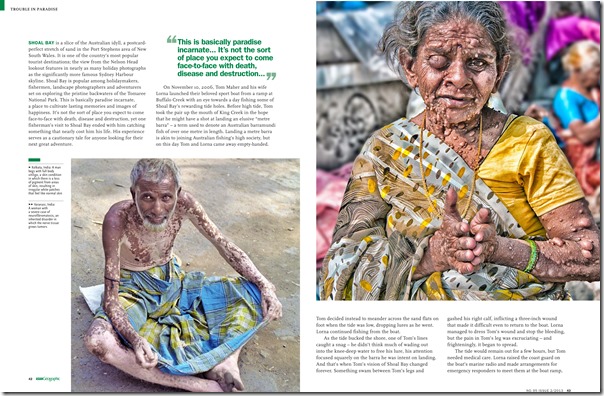

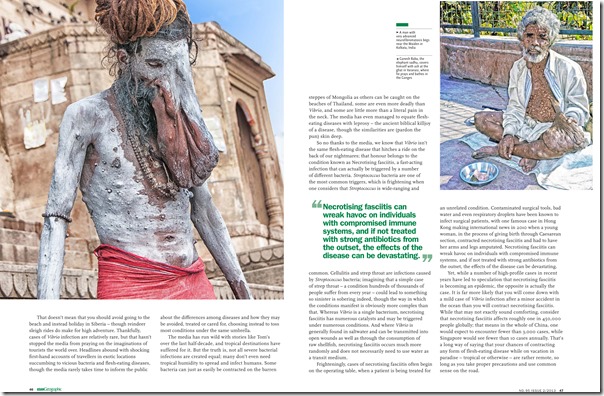

TROUBLE IN PARADISE: Not all Bacteria are Created Equal
For Asian Geographic Magazine
Shoal Bay is a slice of the Australian idyll, a postcard-perfect stretch of sand in New South Wales’ Port Stephens area. Shoal Bay is one of Australia’s most popular tourist destinations; the view from the Nelson Head lookout features in nearly as many holiday photographs as the significantly more famous Sydney harbor skyline. Shoal Bay is popular among holiday makers, fishermen, landscape photographers, and adventurers set on exploring the pristine backwaters of the Tomaree National Park. This is a destination that is basically paradise incarnate, a place to cultivate lasting memories and images of happiness. It’s not the sort of place you expect to come face to face with death, disease, and destruction, yet one fisherman’s visit to Shoal Bay ended with him catching something that nearly cost him his life. His tale is a cautionary one for anyone looking for their next great adventure.
On November 10, 2006, Tom Maher and his wife Lorna launched their beloved sport boat from a ramp at Buffalo Creek with an eye towards a day fishing some of Shoal Bay’s rewarding tide holes. Before high tide Tom took the pair up the mouth of King Creek in the hope that he might have a shot at landing an elusive metre barra – a term used to denote an Australian Barramundi fish of over 1m in length. Landing a metre barra is akin to joining Australian fishing’s high society, but on this day Tom and Lorna came away empty handed. Tom decided instead to meander across the sand flats on foot when the tide was low, dropping lures as he went. Lorna continued fishing from the boat.
As the tide bucked the shore, one of Tom’s lines caught a snag – he didn’t think much of wading out into the knee-deep water to free his lure, his attention focused squarely on the barra he was intent on landing. And that’s when Tom’s vision of Shoal Bay changed forever. Something swam between Tom’s legs and gashed his right calf, inflicting a three-inch wound that made it difficult even to return to the boat. Lorna managed to dress Tom’s wound and stop the bleeding, but the pain in Tom’s leg was excruciating – and frighteningly, it began to spread. The tide would remain out for a few hours, but Tom needed medical care. Lorna raised the coast guard on the boat’s marine radio and made arrangements for emergency responders to meet them at the boat ramp as soon as they could manage the tide. Five hours would pass between the time of the injury and Tom’s first encounter with professional medical personnel. Sated by painkillers, Tom assumed that his wound would be cleaned and stitched up, and after a few hours he would be on his way home, a sore leg and a fresh scar his only souvenirs from a day on Shoal Bay.
But a few days later the three-inch gash had become a gaping hole a big barra could swim through. Three weeks later Tom was still in the hospital, on a steady regiment of high-powered antibiotics and resting in the hospital’s sterilized hypobaric chamber. This was Tom’s introduction to the waylaying scourge known as Vibrio, a bacteria carried by numerous sea creatures, found in most warm water coastal areas, and frequently transmitted to humans who consume raw shellfish. Certain pathogenic species of Vibrio manifest as flesh eating diseases, and are generally lethal. Tom may have encountered the species known as Vibrio vulnificus, the same species that wreaked havoc on New Orleans in the aftermath of Hurricane Katrina, and raised the global profile of pseudo-flesh eating diseases. Tom may have been bitten by a shark or a baby crocodile, stung by a ray, slashed by the fins of any number of spiny fish, or cut his leg on a piece of broken glass – the cause of the injury is inconsequential, since the water itself was the carrier of the pathogen. Without proper medical attention Tom‘s symptoms would have steadily become more grave – aside from the staggering pain, Vibrio infections lead to severe vomiting, blistering, explosive diarrhea, and, in a shocking number of cases, septicemia and death. Once Vibrio has settled in the human bloodstream, mortality is 50 percent – even when the bacteria are battled with the best in modern health care. While Tom’s story has a happy ending – his doctors defeated the infection and he received a skin graft to repair the damage to his leg – though his vision of paradise was certainly altered by his brush with a bacteria that is found in all the world’s tropical waters. That’s right – no paradise is safe from these severe bacteria. And some places are less safe than others.
That doesn’t mean that you should avoid going to the beach and instead holiday in Siberia – though reindeer sleigh rides do make for high adventure. Thankfully, cases of Vibrio are relatively rare, but that hasn’t stopped the media from praying on the imaginations of travelers the world over. Headlines abound with shocking first-hand accounts of travelers in exotic locations succumbing to vicious bacteria and flesh eating diseases, though the media rarely takes time to inform the public about the differences among diseases and how they may be avoided, treated, or cared for, choosing instead to toss most conditions under the same umbrella. The media has run wild with stories like Tom’s over the last half-decade, and tropical destinations have suffered for it. But the truth is, not all severe bacterial infections are created equal; many don’t even need tropical humidity to spread and infect humans. Some bacteria can just as easily be contracted on the barren steppes of Mongolia as others can be caught on the beaches of Thailand, some are more deadly than Vibrio, and some are little more than a literal pain in the neck. The media has even managed to equate flesh-eating diseases with leprosy – the old ancient biblical killjoy of a disease, though the similarities are (pardon the pun) skin deep. Causes, effects, and the social stigma associated with leprosy in contemporary Asia is an entirely different paper for another time.
So no thanks to the media, we know that Vibrio isn’t the same flesh-eating disease that hitches a ride on the back of our nightmares; that honor belongs to the condition known as Necrotizing fasciitis, a fast-acting infection that can actually be triggered by a number of different bacteria. Streptococcus bacteria are one of the most common triggers, which is frightening when one considers that streptococcus is wide ranging and common. Cellulitis and strep throat are infections caused by Streptococcus bacteria; imagining that a simple case of strep throat – a condition hundreds of thousands of people suffer from every year – could lead to something so sinister is sobering indeed, though the way in which the conditions manifests is obviously more complex than that. Whereas Vibrio is a single bacterium, necrotizing fasciitis has numerous catalysts and may be triggered under numerous conditions. And where Vibrio is generally found in saltwater and can be transmitted into open wounds as well as through the consumption of raw shellfish, necrotizing fasciitis occurs much more randomly, and does not necessarily need to use water as a transit medium.
Frighteningly, cases of necrotizing fasciitis often begin on the operating table, when a patient is being treated for an unrelated condition. Contaminated surgical tools, bad water, and even respiratory droplets have been known to infect surgical patients, with one famous case in Hong Kong making international news in 2010 when a young woman, in the process of giving birth through a C-section, contracted necrotizing fasciitis and had to have her arms and legs amputated. Necrotizing Fasciitis can wreak havoc on individuals with compromised immune systems, and if not treated with strong regiments of antibiotics from the outset, can render devastating results to the individual infected. Yet while a number of high-profile cases in recent years have led to speculation that necrotizing fasciitis is becoming an epidemic, the opposite is actually the case. It is far more likely that you will come down with a mild case of Vibrio after a minor accident in the ocean than you will contract necrotizing fasciitis, and while that may not exactly sound comforting, consider that necrotizing fasciitis affects roughly 1 in 450,000 people globally; that means in the whole of China one would expect to encounter fewer than 3,000 cases, while Singapore would see fewer than 10 cases annually. That’s a long way of saying that your chances of contracting any form of flesh-eating disease while on vacation in paradise – tropical or otherwise – are rather remote, so long as you take proper precautions and use common sense on the road.
Limited global cases of flesh-eating diseases also mean scientists have a small sample size within which they are able to conduct research related to cures and treatments – making combating these fast-acting bacteria even more difficult. But when scientists began focusing on wound cleansing prevention solutions rather than bacteria-battling cures, a breakthrough occurred. American scientists from Atlanta, Georgia recently pioneered an antibacterial wound cleaning technology that makes contracting bacteria like Vibrio or staff difficult in the first place; the wound cleaner, pioneered by Dr. Branson Ritchie and known as Silvaklenz, attacks the cell membrane of the infecting bacteria, and helps injured areas transform from chronic to acute in a fraction of the time conventional antibiotic treatments do their dirty work. The product is being deployed all over the world, though associated costs – the biggest factor in combating dangerous bacteria and infectious diseases – means that Silvaklenz may not be available to a wide Asian marketplace for a number of years. But swift FDA approvals in America mean that generic licensing agreements may soon make it available at a fraction of the price all across the world. Dr. Ritchie is convinced that Silvaklenz will eventually become a mainstay in hospitals and a fixture in first-aid kits sold around the world; had Tom had Silvaklenz in his medical kit aboard the boat on Shoal Bay, he could have avoided the infection that nearly cost him his leg in the first place, and been in and out of the hospital in a few hours to fix the cut like he originally envisioned.
Dr. Ritchie often references the case of 24-year-old Aimee Copeland, an American girl who was diagnosed with necrotizing fasciitis after cutting herself when falling from a broken zipline. The infection cost Aimee, an otherwise healthy adult, her left leg, right foot, and hands. "If [Aimee] got the wound and this would have been in her first-aid kit, the wound would’ve been cleansed immediately; it would have been soaked down with the Silvaklenz,” Dr. Ritchie said. “Then those bacteria may never have gotten started. And if they hadn’t started, we don’t have to worry about them continuing to do damage to her body." Dr. Ritchie and his medical research team have showed in controlled lab trials that their product is able to prevent necrotizing fasciitis, and is also effective at treating forms similar to the aeromonas hydrophila bacteria species that afflicted Aimee.
Popular media would like us to believe that one bacterium is as good as the other and is just as capable of doing us grave harm, when in reality all bacteria are different – and all bacteria affect all people differently. Not all bacteria are created equal, and some are easily enough defended against by the human body. But there are certain super strains of bacteria that can yield devastating effects on even otherwise strong, healthy individuals – as seen in the case of the disaster at Shoal Bay. While it’s unlikely that antibiotic superdrugs like Silvaklenz are currently part of your travel kit, you can minimize your risk of exposure to dangerous bacteria by exercising common sense near coastal areas, estuaries, or gulf streams – and/or any area where pathogens have been known to occur, as in the case with necrotizing fasciitis.
Helpful tips to avoid bacteria when traveling:
1. Cook all seafood caught in coastal waters
2. Avoid raw oysters or any raw shellfish
3. Do not expose broken or damaged skin to sea water
4. Treat any injury promptly; clean and dress all wounds
5. Seek medical attention as soon as infection begins to spread
– flash
PS: I’m much better at updating my Facebook page, so if you’re so inclined, head over there for the last goings on from the empire. Click to join me on Facebook
